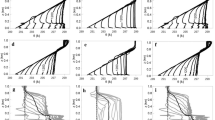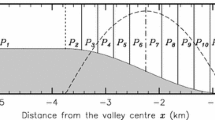Abstract
A series of surveys was carried out with an instrumented vehicle along the A361 in south-west England between 20 January and 4 April 2007, primarily during clear calm nights in order to observe the formation of pools of cold air in valleys. High resolution simulations were performed for three of these cases using the Met Office Unified Model (MetUM®), which was shown to successfully reproduce many of the features of the observed along-route variations in air temperature. Analysis of the observations and the results of the simulations suggest that the cooling of air within these moderate valleys was the result of sheltering, which reduces the turbulent flux of heat down from aloft. Valleys that experience a large degree of cooling are those that become fully decoupled, allowing the near-surface air within the valley to cool rapidly in response to the surface longwave radiative cooling. The behaviour of the valley cooling intensity is shown to be similar to that observed in idealised simulations of the sheltering mechanism (Vosper and Brown, 2008, Boundary-Layer Meteorol 127:429–448).
Similar content being viewed by others
References
Barr S, Orgill MM (1989) Influence of external meteorology on nocturnal valley drainage winds. J Appl Meteorol 28: 497–517
Davies T, Cullen MJP, Malcolm AJ, Mawson MH, Staniforth A, White AA, Wood N (2005) A new dynamical core for the Met Office’s global and regional modelling of the atmosphere. Q J Roy Meteorol Soc 131: 1759–1782
Edwards JM, Slingo A (1996) Studies with a flexible new radiation code. I: choosing a configuration for a large-scale model. Q J Roy Meteorol Soc 122: 689–719
Essery RLH, Best MJ, Betts RA, Cox PM (2003) Explicit representation of subgrid heterogeneity in a GCM land surface scheme. J Hydrometeorol 4: 530–543
Gudiksen PH, Leone JM Jr, King CW, Ruffieux D, Neff WD (1992) Measurements and modelling of the effects of ambient meteorology on nocturnal drainage flows. J Appl Meteorol 31: 1023–1032
Gustavsson T (1995) A study of air and road surface temperature variations during clear windy nights. Int J Climatol 15: 919–932
Gustavsson T, Karlsson M, Bogren J, Lindqvist S (1998) Development of temperature patterns during clear nights. J Appl Meteorol 57: 559–571
King JC, Connolley WM, Derbyshire SH (2001) Sensitivity of modelled Antarctic climate to surface and boundary-layer flux parameterisations. Q J Roy Meteorol Soc 127: 779–794
Kondo J, Sato T (1988) A simple model of drainage flow on a slope. Boundary-Layer Meteorol 43: 103–123
Lock AP, Brown AR, Bush MR, Martin GM, Smith RNB (2000) A new boundary layer scheme for the unified model. Part I: scheme description and single-column model tests. Mon Weather Rev 128: 3187–3199
Neff WD, King CW (1989) The accumulation and pooling of drainage flows in a large basin. J Appl Meteorol 28: 518–529
Oliphant AJ, Spronken-Smith RA, Sturman AP, Owens IF (2003) Spatial variability of surface radiation fluxes in mountainous terrain. J Appl Meteorol 42: 113–128
Raymond WH (1988) High order low-pass implicit tangent filters for use in finite area calculations. Mon Weather Rev 116: 2132–2141
Thompson BW (1986) Small-scale katabatics and cold hollows. Weather 41(5): 146–153
Vosper S, Brown A (2008) Numerical simulations of sheltering in valleys: the formation of night-time cold-air pools. Boundary-Layer Meteorol 127: 429–448
Zangl G (2005) Formation of extreme cold-air pools in elevated sinkholes: an idealised numerical process study. Mon Weather Rev 133: 925–941
Author information
Authors and Affiliations
Corresponding author
Rights and permissions
About this article
Cite this article
Smith, S.A., Brown, A.R., Vosper, S.B. et al. Observations and Simulations of Cold Air Pooling in Valleys. Boundary-Layer Meteorol 134, 85–108 (2010). https://doi.org/10.1007/s10546-009-9436-9
Received:
Accepted:
Published:
Issue Date:
DOI: https://doi.org/10.1007/s10546-009-9436-9




